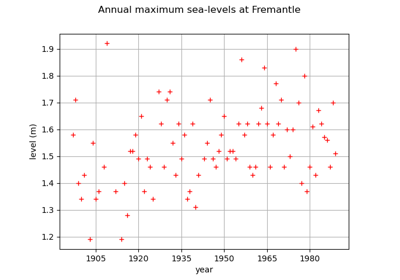TimeVaryingResult¶
- class TimeVaryingResult(*args)¶
Distribution factory result for non stationary likelihood estimation.
We consider a non stationary GEV model to describe the distribution of
:
We have the values of
on the time stamps
.
For numerical reasons, the time stamps have been normalized using the linear function:
Each of
has an expression in terms of a parameter vector and time functions:
where:
is usually referred to as the inverse-link function. The function
denotes either
,
or
,
each
is a scalar function
,
each
.
We denote by
,
and
the size of the functional basis of
,
and
respectively. We denote by
the complete vector of parameters.
The estimator of vector
maximizes the likelihood of the Parent distribution.
- Parameters:
- factory
DistributionFactory Parent distribution factory.
- data2-d sequence of float
Data.
- parameterFunction
Function The function
.
- timeStamps2-d sequence of float
Values of
.
- parameterDistribution
Distribution The distribution of
.
- normalizationFunction
LinearFunction The normalization function
.
- llhfloat
Maximum log-likelihood.
- factory
See also
Methods
Draw the 4 usual diagnostic plots.
drawParameterFunction([parameterIndex])Draw the parameter function.
Draw the quantile function.
Accessor to the object's name.
Accessor to the Parent distribution at a given time.
getId()Accessor to the object's id.
Optimal log-likelihood value accessor.
getName()Accessor to the object's name.
Normalizing function accessor.
Optimal parameter accessor.
Accessor to the distribution of
.
Parameter function accessor.
Accessor to the object's shadowed id.
Accessor to the object's visibility state.
hasName()Test if the object is named.
Test if the object has a distinguishable name.
setLogLikelihood(logLikelihood)Optimal log-likelihood value accessor.
setName(name)Accessor to the object's name.
setParameterDistribution(parameterDistribution)Accessor to the distribution of of
.
setShadowedId(id)Accessor to the object's shadowed id.
setVisibility(visible)Accessor to the object's visibility state.
getTimeGrid
- __init__(*args)¶
- drawDiagnosticPlot()¶
Draw the 4 usual diagnostic plots.
If
is a non stationary GEV model defined as follows:
then the standardized variables
defined by:
have the standard Gumbel distribution which is the GEV model with
.
Then, the 4 diagnostic graphs are built from the transformed data compared to the Gumbel model: the probability-probability plot, the quantile-quantile plot, the return level plot, the data histogram with the Gumbel distribution.
If
denotes the ordered block maximum transformed data, the graphs are defined as follows.
The probability-probability plot consists of the points:
The quantile-quantile plot consists of the points:
The return level plot consists of the points:
and the points:
where
is the empirical
-block return level of the transformed data and
the
-block return level of the Gumbel distribution.
- Returns:
- grid
GridLayout - Returns a grid of 4 graphs:
the QQ-plot,
the PP-plot,
the return level graph (with confidence lines),
the density graph.
- grid
- drawParameterFunction(parameterIndex=0)¶
Draw the parameter function.
- Parameters:
- parameterIndexint,
The index
specifying the marginal of
.
- Returns:
- graph
Graph Graph of
.
- graph
- drawQuantileFunction(p)¶
Draw the quantile function.
The quantile function is the function
where
is the quantile of order
of the Parent distribution at time
.
- Parameters:
- pfloat
The quantile level.
- Returns:
- graph
Graph Quantile function graph.
- graph
- getClassName()¶
Accessor to the object’s name.
- Returns:
- class_namestr
The object class name (object.__class__.__name__).
- getDistribution(t)¶
Accessor to the Parent distribution at a given time.
- Parameters:
- tfloat
Time value.
- Returns:
- distribution
Distribution The Parent distribution at time
.
- distribution
- getId()¶
Accessor to the object’s id.
- Returns:
- idint
Internal unique identifier.
- getLogLikelihood()¶
Optimal log-likelihood value accessor.
- Returns:
- llhfloat
Maximum log-likelihood.
- getName()¶
Accessor to the object’s name.
- Returns:
- namestr
The name of the object.
- getNormalizationFunction()¶
Normalizing function accessor.
- Returns:
- normalizeFunction
Function The function
.
- normalizeFunction
- getOptimalParameter()¶
Optimal parameter accessor.
- Returns:
- optimalParameter
Point Optimal vector of parameters
.
- optimalParameter
- getParameterDistribution()¶
Accessor to the distribution of
.
- Returns:
- parameterDistribution
Distribution The distribution of the estimator of
.
- parameterDistribution
- getParameterFunction()¶
Parameter function accessor.
- Returns:
- parameterFunction
Function The function
.
- parameterFunction
- getShadowedId()¶
Accessor to the object’s shadowed id.
- Returns:
- idint
Internal unique identifier.
- getVisibility()¶
Accessor to the object’s visibility state.
- Returns:
- visiblebool
Visibility flag.
- hasName()¶
Test if the object is named.
- Returns:
- hasNamebool
True if the name is not empty.
- hasVisibleName()¶
Test if the object has a distinguishable name.
- Returns:
- hasVisibleNamebool
True if the name is not empty and not the default one.
- setLogLikelihood(logLikelihood)¶
Optimal log-likelihood value accessor.
- Parameters:
- llhfloat
Maximum log-likelihood.
- setName(name)¶
Accessor to the object’s name.
- Parameters:
- namestr
The name of the object.
- setParameterDistribution(parameterDistribution)¶
Accessor to the distribution of of
.
- Parameters:
- parameterDistribution
Distribution The distribution of the estimator of
.
- parameterDistribution
- setShadowedId(id)¶
Accessor to the object’s shadowed id.
- Parameters:
- idint
Internal unique identifier.
- setVisibility(visible)¶
Accessor to the object’s visibility state.
- Parameters:
- visiblebool
Visibility flag.
 OpenTURNS
OpenTURNS


